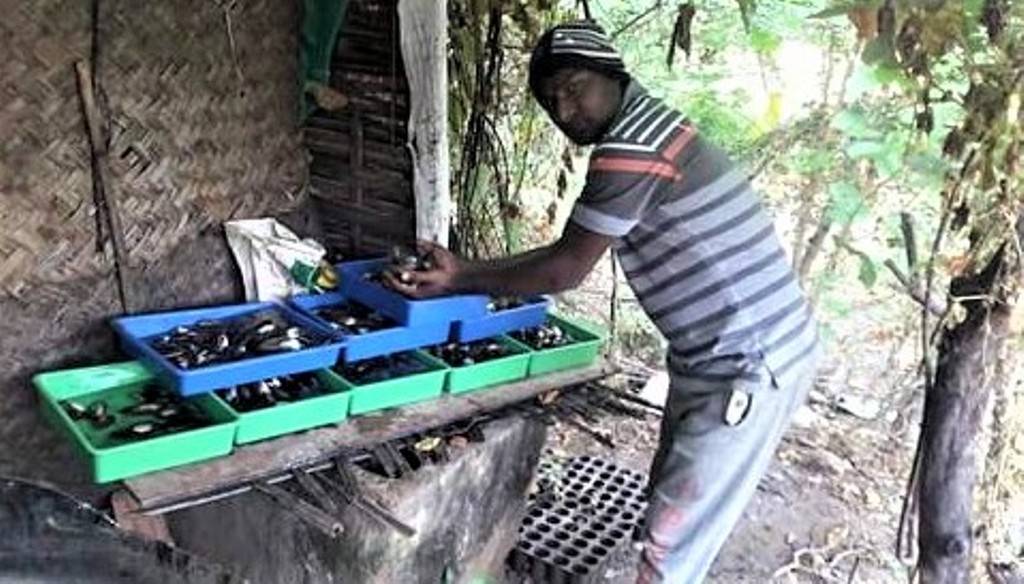
Albert Einstein said, “If you always do what you what you always did, you will always get what you always got”. Sanjay Gandate from Maharashtra’s Pardi Kupi village also believed in this saying and this is what pushed him to try something different than the traditional way of pearl cultivation, which was completely dependent on weather.
He is a third-generation farmer from the village in Naxal-affected Gadchiroli district; He took a unique path to supplement his erratic earnings from rice fields – Pearl Cultivation.
His grandfather as well as his father had always grown rice in their own 3-acre ancestral land. As a child, he would visit their farm which is located near Wainganga Rive. And, there he would find many shells by the river & be very fascinated by the stories of his grandfather told him about shells.
“My grandfather told me that the pearls are formed inside these shells. He said that when the first drop of the first rain of the season enters the shells, it naturally becomes a pearl. This theory sounded this story of my grandfather sounded so interested to me that I started researching about it” said Sanjay, while talking to the TBI from Gadchiroli.
After listening to so many stories about the pearl, he concludes that there must be something that has to go inside the shell when the oyster is alive to form a pearl. During his research, he realized that the pearls are not naturally shiny, white & round as shown in many pictures.
He kept on collecting those shells from the river & found some of them filled with the pebble-shaped thing which is covered with sand & dirt. Later, he realized that those were the pearls.
In 2002, when he was in 11th Std, he started experimenting, he would get live oysters from the river & put a tiny pebble in it. He would then put oysters in a bucket full of water & wait for days. Initially, the oyster would not live a longer period of time & this does not stop him from experimenting more.
After months of experimenting, he found that the pearls are formed with chemical released by the oyster when it feels irritation due to any foreign body inside it. After almost 15 layers of this chemical sticks to a foreign body by giving it a shape of a pearl.
Sanjay informs that “Just like our eyes release the tears if there is a foreign body inside it; similarly oyster releases a chemical which sticks on this body to form pearls. However, this body does not have to be so strong that the oyster dies & not so weak that it cannot survive chemical pressure & moves out of the shell”.
When Sanjay got the results by experimenting few shells, he then rented a freshwater pond, gathered tools from his own household to surgically implement the mantle graft & appropriate nuclei in the internal organs of oysters.
After the setup was ready, he fished out around 5,000 oysters. He said that it takes around 18 – 20 months to form a good quality pearl. But the only condition is that it should be reared in freshwater & the oyster should be alive till pearls are formed. He adds fish into the pond, to keep it clean.
After 9 months he took care of these pearls just like his babies, many times the villagers laughed at him because they have no idea about what the pearl is.
When the pearl have almost formed at that time, the Naxals have attacked them and spoiled the oysters, as he wants to become a teacher, he then focused on his studies and during the break, he again rented a pond and started pearl farming but then again, when the oysters were almost ready, it was stolen.
Even this does not stop Sanjay, In 2015 he again started pearl farming but this time he made his own tank in his house & has grown almost 5,000 pearls. He was mentioned in the state revenue minister’s address to the legislative council as an example for the other farmers.
Sanjay believes in gathering knowledge & is a student of 4th year LLB student; he is additionally fulfilling his dreams of becoming a teacher by conducting workshops & training for others to grow pearls.
“Everyone was opposing me when I started the pearl farming again, my parents said that we are poor farmers & we must work on something that gives us enough money every day and not after a year & a half, but now even they are happy with the profit that I have made through the pearl farming,” says proud Sanjay.
Sanjay has earned Rs 10 to 12 lakhs from pearls. He says that this kind of farming requires minimal investment & high returns, but only if the farmers are ready to work hard. He has invested Rs 5,000 to build a freshwater tank in his house.
He concludes that “I want to give a message to the farmers that always listen to your heart & mind. Try different forms of farming and have faith in yourself. If you work for hand& have faith, you will definitely succeed”.
To know more about pearl farming or to attend Sanjay Gandate’s Workshop on Perl Farming, you can direct him through this number: 9689763821
















